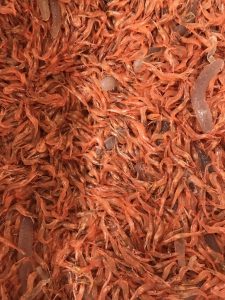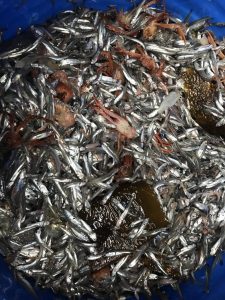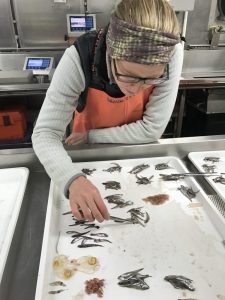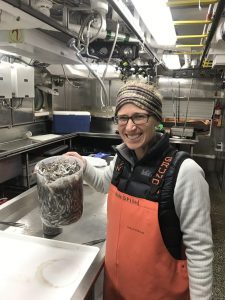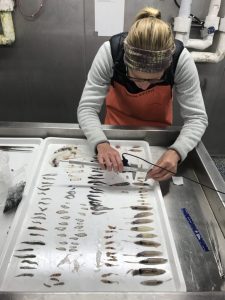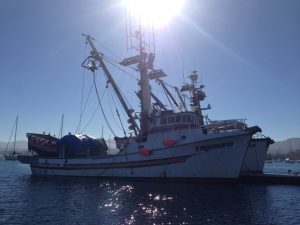 I’m back out at sea on the NOAA Southwest Fisheries Science Center’s annual rockfish recruitment cruise. I’m on a slightly longer leg this year (June 1st-13th), but I’ve got a great route along the entire California coast – Eureka to San Diego. We’re also on a much swankier boat this year than in years past (the newly-commissioned NOAA R/V Reuben Lasker). The Lasker is a ship outfitted for science on the West Coast of the US, and provides a great platform for the trawl surveys that are the basis of the rockfish cruise each year.
I’m back out at sea on the NOAA Southwest Fisheries Science Center’s annual rockfish recruitment cruise. I’m on a slightly longer leg this year (June 1st-13th), but I’ve got a great route along the entire California coast – Eureka to San Diego. We’re also on a much swankier boat this year than in years past (the newly-commissioned NOAA R/V Reuben Lasker). The Lasker is a ship outfitted for science on the West Coast of the US, and provides a great platform for the trawl surveys that are the basis of the rockfish cruise each year.
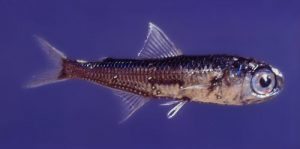 Though the main goal of the cruise is to estimate the number of larval rockfish in the open ocean for management of California’s rockfish fisheries, we do all sorts of other sampling. Marine mammals and seabirds are counted during all hours of daylight, CTD (conductivity to measure salinity, temperature and depth/pressure) measurements are taken at every sampling site and at other sites up and down the coast to help us better understand the relationship between the physical ocean environment and the fish that we catch, zooplankton samples are collected and identified, and all species brought up in the night midwater trawl nets are identified, sometimes measured and recorded. This is everything from larval hake and market squid (two other very important fish species for California’s economy) to pelagic cnidarians (jellyfish!) and myctophid fishes like the California headlightfish.
Though the main goal of the cruise is to estimate the number of larval rockfish in the open ocean for management of California’s rockfish fisheries, we do all sorts of other sampling. Marine mammals and seabirds are counted during all hours of daylight, CTD (conductivity to measure salinity, temperature and depth/pressure) measurements are taken at every sampling site and at other sites up and down the coast to help us better understand the relationship between the physical ocean environment and the fish that we catch, zooplankton samples are collected and identified, and all species brought up in the night midwater trawl nets are identified, sometimes measured and recorded. This is everything from larval hake and market squid (two other very important fish species for California’s economy) to pelagic cnidarians (jellyfish!) and myctophid fishes like the California headlightfish.
I’m on this cruise for several reasons. First, folks at NOAA’s Southwest Fisheries Science Center have been extremely helpful to me during my Ph.D. work. They’ve been generous with their time and happy to think about dissertation questions with me. So in turn, I’m happy to fill in on a leg of the cruise where they’re short-handed on scientists. Second, this is a great opportunity to collect some of my own samples.
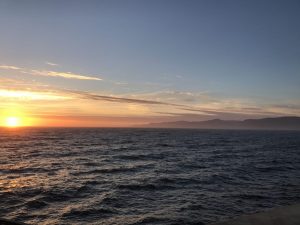
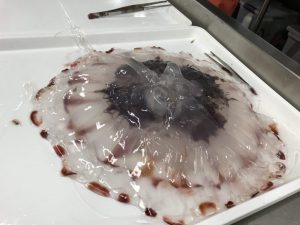
I’m interested in the connection between ecosystems. In the kelp forests of central Californian, fish rely on energy derived from two distinct food chains – (1) energy from macroalgae (primarily giant kelp) in the forest itself, and (2) energy from phytoplankton in the open ocean (the system we’re sampling on this cruise!). A connection. Phytoplankton dynamics and prey resources in the open ocean impact the kelp forest food web. For example, the recruitment of juvenile crabs to the kelp forest (crabs that have been feeding on phytoplankton in the open ocean) could provide an energy-rich food source for benthic fishes. Or an influx of ctenophores (a jellyfish-like organism) from the California Current could provide easily accessible and abundant food for midwater-feeding blue rockfish. This seems plausible, even likely, but quantitatively showing the food web connection and the importance of the connection is not always straight-forward.
I’m on the cruise taking samples of organisms that I know (or suspect) are occasionally carried to the kelp forest on currents. Size measurements will give me an idea of the size distribution of these organisms in the open ocean environment, and for now, I’ll have to assume that their size distribution in the kelp forest would look similar. Counts of the animals give me estimates of density. I’m still not sure how I can use open ocean density to estimate density in the kelp forest…that’s a work in progress. Finally, frozen samples I keep will be burned in a bomb calorimeter to tell me how much energy a fish would gain from eating one individual salp, jellyfish, pelagic red crab (or any of the other organisms that I’ve sampled). Basically, I’ll get a calorie count for each open ocean prey item that a kelp forest rockfish might eat. Based on my estimates of the density and average size of an open ocean animal in the kelp forest, and how much energy each provides, I can start a more in-depth analysis of the importance of this connection. If the energy provided is significant relative to the energy a fish gets from prey items that live in the kelp forest, I’ll continue to pursue these questions. If not, maybe prey from the open ocean provides a convenient and tasty treat for fish, but doesn’t influence wider population and ecosystem dynamics. Only time, samples, and more science will tell.
We also had a NOAA Teacher-at-Sea aboard the Lasker during this leg! He’s an 8th-grade and high school science teacher creating lessons about West coast fisheries. Check out his blog here.
